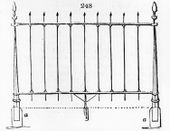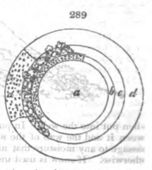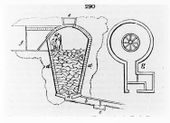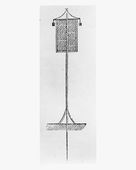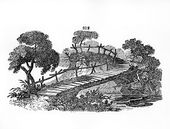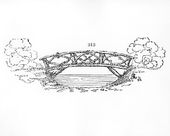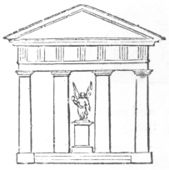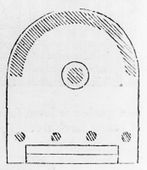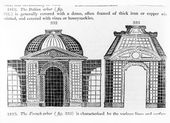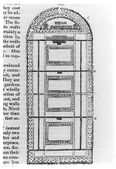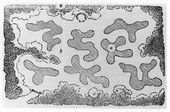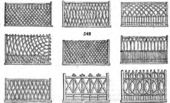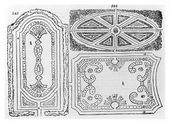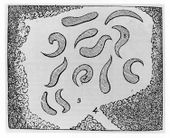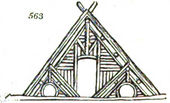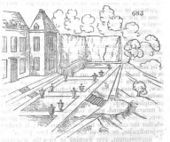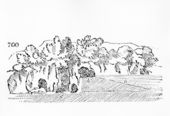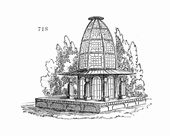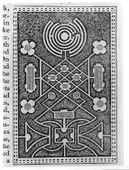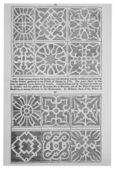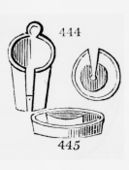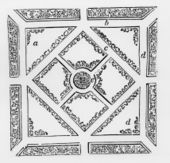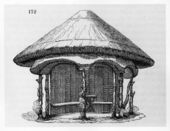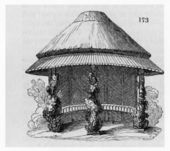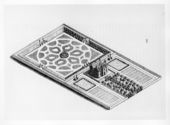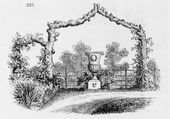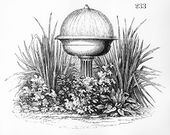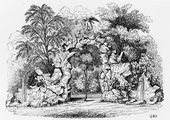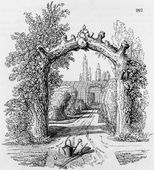J. C. (John Claudius) Loudon
[http://www.nga.gov/content/ngaweb/research/casva/research-projects.html A Project of the National Gallery of Art, Center for Advanced Study in the Visual Arts ]
Revision as of 20:33, December 8, 2014 by C-tompkins (talk | contribs) (→An Encyclopaedia of Gardening (1826))
Sites
Terms
Texts
An Encyclopaedia of Gardening (1826)
Fig. 11, J. C. Loudon, "Ponds or large basins" and "Tanks or cisterns," in An Encyclopaedia of Gardening (1826), p. 339, figs. 286-288.
- 1826, An Encyclopaedia of Gardening (p. 339) [1]
- “1719. Ponds or large basins . . . are reservoirs formed in excavations, either in soils retentive of water, or rendered so by the use of clay. . . . Sometimes these basins are lined with pavement, tiles, or even lead, and the last material is the best, where complete dryness is an object around the margin.” [Fig. 11]
- 1826, An Encyclopaedia of Gardening (pp. 339) [1]
- “1722. Collecting and preserving ice, rearing bees, &c. however, unsuitable or discordant it may appear, it has long been the custom to delegate to the care of the gardener. In some cases also he has the care of the dove-house, fish-ponds, aviary, a menagerie of wild beasts, and places for snails, frogs, dormice, rabbits, &c. but we shall only consider the ice-house, apiary, and aviary, as legitimately belonging to gardening, leaving the others to the care of the gamekeeper, or to constitute a particular department in domestic or rural economy. . . .

Fig. 6, J. C. Loudon, "The apiary, or bee-house," in An Encyclopaedia of Gardening (1834), p. 613, fig. 620.
- 1826, An Encyclopaedia of Gardening (pp. 341–42, 801–2) [1]
- “1733. The care of bees seems more naturally to belong to gardening than the keeping of ice; because their situation is naturally in the garden, and their produce is a vegetable salt. The garden-bee is found in a wild state in most parts of the globe, in swarms or governments; but never in groups of governments so near together as in a bee-house, which is an artificial and unnatural contrivance to save trouble, and injurious to the insect directly as the number placed together. . . . Hence, independently of other considerations, one disadvantage of congregating hives in bee-houses or apiaries. The advantages are, greater facility in protecting from heats, colds, or thieves, and greater facilities of examining their condition and progress. Independently of their honey, bees are considered as useful in gardens, by aiding in the impregnation of flowers. For this purpose, a hive is sometimes placed in a cherry-house, and sometimes in peach-houses; or the position of the hive is in the front or end wall of such houses, so as the body of the hive may be half in the house and half in the wall, with two outlets for the bees, one into the house, and the other into the open air. By this arrangement, the bees can be admitted to the house and open air alternately, and excluded from either at pleasure.
- “1734. The apiary, or bee-house. The simplest form of a bee-house consists of a few shelves in a recess of a wall or other building . . . exposed to the south, and with or without shutters, to exclude the sun in summer, and, in part, the frost in winter. The scientific or experimental bee-house is a detached building of boards, differing from the former in having doors behind, which may be opened at any time during day to inspect the hives. . . . Bee-houses may always be rendered agreeable, and often ornamental objects: they are particularly suitable for flower-gardens; and one may occur in a recess in a wood or copse, accompanied by a picturesque cottage and flower-garden. They enliven a kitchen-garden, and communicate particular impressions of industry and usefulness. . . . [Fig. 6]
- “6127. Decorations. Even the apiary and aviary, or, at least, here and there a beehive, or a cage suspended from a tree, will form very appropriate ornaments.”
- 1826, An Encyclopaedia of Gardening (pp. 348, 350–51) [1]
- “1769. Useful decorations are such as while they serve as ornaments, or to heighten the effect of a scene, are also applied to some real use, as in the case of cottages and bridges. They are the class of decorative buildings most general and least liable to objection. . . .
- “1782. The bridge is one of the grandest decorations of garden-scenery, where really useful. None require so little architectural elaboration, because every mind recognises the object in view, and most minds are pleased with the means employed to attain that object in proportion to their simplicity. There are an immense variety of bridges, which may be classed according to the mechanical principles of their structure; the style of architecture, or the materials used. . . .
- “1783. The fallen tree is the original form, and may sometimes be admitted in garden-scenery, with such additions as will render it safe, and somewhat commodious.
- “1784. The foot-plank is the next form, and may or may not be supported in the middle, or at different distances by posts.
- “1785. The Swiss bridge . . . is a rude composition of trees unbarked, and not hewn or polished. . . . [Figs. 9 and 10]
- “1787. A very light and strong bridge may be formed by screwing together thin boards in the form of a segment, or by screwing together a system of triangles of timber. . . .
- “1788. Bridges of common carpentry . . . admit of every variety of form, and either of rustic workmanship or with unpolished materials, or of polished timber alone, or of dressed timber and abutments of masonry.
- “1789. Bridges of masonry . . . may either have raised or flat roads; but in all cases those are the most beautiful (because most consistent with utility) in which the road on the arch rises as little above the level of the road on the shores as possible. . . .
- “1790. Cast-iron bridges are necessarily curved; but that curvature, and the lines which enter into the architecture of their rails, may be varied according to taste or local indications.”

Fig. 1, J. C. Loudon, "Alcoves," in An Encyclopaedia of Gardening (1826), p. 356, fig. 331.
- 1826, An Encyclopaedia of Gardening (p. 356) [1]
- "1810. Alcoves . . . are used as winter resting places, as being fully exposed to the sun." [Fig. 1]
- 1826, An Encyclopaedia of Gardening (p. 356) [1]
- “1811. Arbors are used as summer seats and resting-places: they may be shaded with fruit-trees, as the vine, currant, cherry; climbing ornamental shrubs, as ivy, clematis, &c.; or herbaceous, as everlasting pea, gourd, &c. They are generally formed of timber lattice-work, sometimes of woven rods, or wicker-work, and occasionally of wire.
- “1812. The Italian arbor . . . is generally covered with a dome, often framed of thick iron or copper wire painted, and covered with vines or honeysuckles.
- “1813. The French arbor . . . is characterised by the various lines and surfaces, which enter into the composition of the roof.”

Fig. 7, J. C. Loudon, Aviary designed by Humphry Repton for the grounds of the Pavilion at Brighton, in An Encyclopaedia of Gardening (1826), p. 1020, fig. 718.
- 1826, An Encyclopaedia of Gardening (pp. 347, 1020) [1]
- “1761. The canary or singing-bird aviary used not unfrequently to be formed in the opaque-roofed green-house or conservatory, by enclosing one or both ends with a partition of wire; and furnishing them with dead or living trees, or spray and branches suspended from the roof for the birds to perch on. Such are chiefly used for the canary, bullfinch, linnet, &c.
- “1762. The parrot aviary is generally a building formed on purpose, with a glass roof, front, and ends; with shades and curtains to protect it from the sun and frost, and a flue for winter heating. In these, artificial or dead trees with glazed foliage are fixed in the floor, and sometimes cages hung on them; and at other times the birds allowed to fly loose. . . .
- “1763. The verdant aviary is that in which, in addition to houses for the different sorts of birds, a net or wire curtain is thrown over the tops of trees, and supported by light posts or hollow rods, so as to enclose a few poles, or even acres of ground, and water in various forms. In this the birds in fine weather sing on the trees, the aquatic birds sail on the water, or the gold-pheasants stroll over the lawn, and in severe seasons they betake themselves to their respective houses or cages. Such an enclosed space will of course contain evergreen, as well as deciduous trees, rocks, reeds, aquatics, long grass for larks and partridges, spruce firs for pheasants, furzebushes for linnets, &c. . . .
- “1764. Gallinaceous aviary. At Chiswick, portable netted enclosures, from ten to twenty feet square, are distributed over a part of the lawn, and display a curious collection of domestic fowls. In each enclosure is a small wooden box or house for sheltering the animals during the night, or in severe weather, and for breeding. Each cage or enclosure is contrived to contain one or more trees or shrubs; and water and food are supplied in small basins and appropriate vessels. Curious varieties of aquatic fowls might be placed on floating aviaries on a lake or pond. . . .
- “7258. Narrow terraces. . . . Where the breadth is more than is requisite for walks, the borders may be kept in turf with groups or marginal strips of flowers and low shrubs. In some cases, the terrace-walls may be so extended as to enclose ground sufficient for a level plot to be used as a bowling-green or a flower-garden. These are generally connected with one of the living-rooms or the conservatory, and to the latter is frequently joined an aviary and the entire range of botanic stoves. Or, the aviary may be made an elegant detached building, so placed as to group with the house and other surrounding objects. An elegant structure of this sort . . . was designed by Repton for the grounds of the Pavilion at Brighton.” [Fig. 7]
- 1826, An Encyclopaedia of Gardening (pp. 358, 1012) [1]
- “1822. Of constructions for displaying water, as an artificial decoration, the principal are cascades, waterfalls, jets, and fountains. . . .
- “1826. The construction of the waterfall, where avowedly artificial, is nothing more than a strong-built wall across the stream, perfectly level at top, and with a strong, smooth, accurately fitted, and well jointed coping. . . . Where a natural waterfall
is to be imitated, the upright wall must be built of huge irregular blocks; the horizontal lamina of water broken in the same way by placing fragments of rocks grouped here and there so as to throw the whole into parts; and as nature is never methodical, to form it as if in part a cascade. . . .
- “1827. In imitating a natural cascade in garden-scenery, the horizontal line must here also be perfect, to prevent waste of water in dry seasons, and from this to the base of the lower slope the surface must be paved by irregular blocks, observing to group the prominent fragments, and not distribute them regularly over the surface. . . .
- “1828. The greatest danger in imitating cascades and waterfalls, consisting in attempting too much, a very few blocks, disposed with a painter’s eye, will effect all that can be in good taste in most garden-scenes; and in forming or improving them in natural rivers, there will generally be found indications both as to situation and style, especially if the country be uneven, or stony, or rocky. . . .
- “7225. A waterfall, or cascade, is an obvious improvement where a running stream passes through a demesne . . . and is to be formed by first constructing a bank of masonry, presenting an inclined plane (a) to the currents, and rendering it impervious to water by puddling (1720.) or the use of proper cements, and next varying the ridge (b) and under side (c), with fragments of rock, so chosen and placed, as not to present a character foreign to what nature may be supposed to have produced there. The adjoining ground generally requires to be raised at such scenes, but may generally be harmonised by plantation. [Fig. 7]
- “7226. Where running water is conducted in forms belonging to the geometric style of gardening, waterfalls and cascades are constructed in the form of crescents, flights of steps, or wavy slopes.”
- 1826, An Encyclopaedia of Gardening (pp. 792–93, 996, 1002, 1020) [1]
- “6093. . . . The ancient geometric style, in place of irregular groups, employed symmetrical forms; in France, adding statues and fountains; in Holland, cut trees and grassy slopes; and in Italy, stone walls, walled terraces, and flights of steps. . . .
- “7161. . . . From these different theories [of landscape gardening], as well as from the general objects or end of gardening, there appear to be two principles which enter into its composition; those which regard it as a mixed art, or an art of design, and which are called the principles of relative beauty; and those which regard it as an imitative art, and are called the principles of natural or universal beauty. The ancient or geometric gardening is guided wholly by the former principles; landscape-gardening, as an imitative art, wholly by the latter; but as the art of forming a country-residence, its arrangements are influenced by both principles. . . .
- “7196. . . . If a deformed space has been restored to natural beauty, we are delighted with the effect, whilst we recollect the difference between the present and the former surface; but when this is forgotten, though the beauty remains, the credit for having produced it is lost. In this respect, the operations on ground under the ancient style, have a great and striking advantage; for an absolute perfection is to be attained in the formation of geometrical forms, and the beauty created is so entirely artificial . . . as never to admit a doubt of its origin. . . .
- “7256. Terrace and conservatory. We observed, when treating of ground, and under the ancient style, that the design of the terrace must be jointly influenced by the magnitude and style of the house, the views from its windows, (that is, from the eye of a person seated in the middle of the principal rooms,) and the views of the house from a distance. In almost every case, more or less of architectural form will enter into these compositions.”
- 1826, An Encyclopaedia of Gardening (pp. 800, 1030) [1]
- “6126. The botanic flower-garden being intended to display something of the extent and variety of the vegetable kingdom, as well as its resemblances and differences, should obviously be arranged according to some system or method of study. In modern times, the choice is almost limited to the artificial system of Linnaeus, and the natural method of Jussieu, though Adanson has given above fifty-six different methods by which plants may be arranged. . . . Whatever method is adopted, the plants may either be placed in regular rows, or each order may be grouped apart, and surrounded by turf or gravel. For a private botanic garden, the mode of grouping on turf is much the most elegant. . . .
- “7323. Botanic gardens. The primary object of botanic gardens is to exhibit a collection of plants for the improvement of botanical science; a secondary object to exhibit living specimens of such plants as are useful in medicine, agriculture, and other arts; and a third is, or ought to be, the acclimating of foreign plants, and their dissemination over the country. In choosing a situation for a botanic garden, the leading object must be proximity to the town, city, or university to which it is to belong; and the next, if attainable, a variety of surface and soil, to aid the necessary formation of composts and aspects for different plants. . . . As the leading object or feature in the view of a botanic garden is the range of hot-houses; and as these must always face the south, it is generally desirable that ground on the north side of the principal public street or road by which it is to be approached, should be preferred to ground on the south side.
- “7325. The form of a botanic garden is a matter of very little consequence: where the extent is small, a square or parallelogram may undoubtedly be made to contain most plants; but where it exceeds four or five acres, any form will answer; and, indeed, if there is a sufficient quantity of ground, the more irregular the form, so much the more variety will there be in the circumferential walks of the garden.”
- 1826, An Encyclopaedia of Gardening (p. 809) [1]
“6157. . . . Light bowers formed of lattice-work, and covered with climbers, are in general most suitable to parterres; plain covered seats suit the general walks of the shrubbery.”
- 1826, An Encyclopaedia of Gardening (pp. 942–43) [1]
- “6813. With respect to the disposition of the trees within the plantation, they may be placed regularly in rows, squares, parallelograms, or quincunx; irregularly in the manner of groups; without undergrowths, as in groves . . . with undergrowths, as in woods . . . all undergrowths, as in copse-woods . . . Or they may form avenues . . . double avenues . . . avenues intersecting in the manner of a Greek cross . . . of a martyr’s cross . . . of a star . . . or of a cross patée, or duck’s foot . . . ”
An Encyclopaedia of Gardening (1834)
The Suburban Gardener (1838)
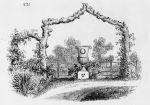
Fig. 7, J. C. Loudon, Rustic arch and vase, in The Suburban Gardener (1838), p. 581, fig. 231.
- 1838, describing the grounds of the Lawrencian Villa, residence of Mrs. Lawrence, Drayton Green, near London, England (p. 581) [2]
- “The next scene of interest is the Italian walk, arrived at the point 8, in which, and looking back towards the paddock, we have, as a termination to one end of that walk, the rustic arch and vase . . . [Fig. 7]
An Encyclopaedia of Gardening (1850)
- 1850, describing Fairmount Waterworks, Philadelphia, Pa. (pp. 332–33) [3]
- “856. Public Gardens. . . .
- “Waterworks at Fair Mount, near Philadelphia. ‘Fair Mount is one of the prettiest spots the eye can look upon. A broad wear is thrown across the river Schuylkill, which produces the sound and look of a cascade. On the farther side of the river is a gentleman’s seat, the beautiful lawn of which slopes down to the water’s edge; and groups of weeping willows and other trees throw their shadows on the stream. The works themselves are enclosed in a simple but very handsome building of freestone, . . . behind the building, and divided from it only by a lawn, rises a lofty wall of solid limestone rock. . . .” [see Fig. 8]
Images
An Encyclopaedia of Gardening (1826)
An Encyclopaedia of Gardening (1834)
- 1316a.jpg
"The zig-zag wall," in An Encyclopaedia of Gardening (1834), p. 578, fig. 568.
- 1316b.jpg
"The square fret wall," in An Encyclopaedia of Gardening (1834), p. 579, fig. 569.
The Suburban Gardener (1838)
An Encyclopaedia of Gardening (1850)
References
Notes
- ↑ 1.00 1.01 1.02 1.03 1.04 1.05 1.06 1.07 1.08 1.09 1.10 1.11 Loudon, J. C. (John Claudius). 1826. An Encyclopaedia of Gardening; Comprising the Theory and Practice of Horticulture, Floriculture, Arboriculture, and Landscape-Gardening. 4th ed. London: Longman et al. view on Zotero
- ↑ Loudon, J. C. (John Claudius). 1838. The Suburban Gardener, and Villa Companion. London: Longman et al. view on Zotero
- ↑ Loudon, J. C. (John Claudius). 1850. An Encyclopaedia of Gardening; Comprising the Theory and Practice of Horticulture, Floriculture, Arboriculture, and Landscape-Gardening. A new ed., cor. amd improved. London: Longman et al. view on Zotero




